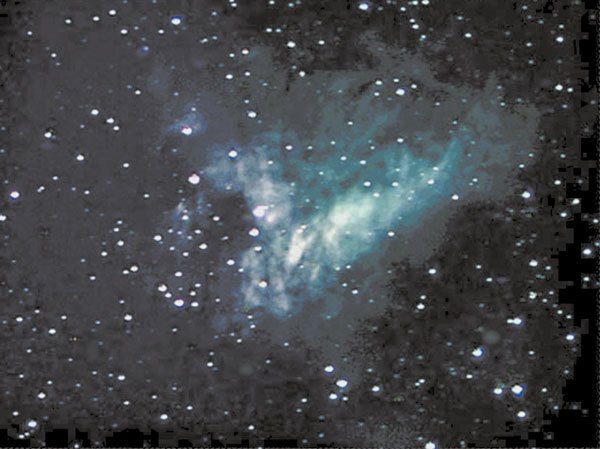Astronomer Charles Messier devoted much of his life to searching
the heavens for comets. In doing so, he came across many objects
that at first he thought were comets, but they actually turned out
to be stationary objects such as nebulas, galaxies, clusters and
double stars.
By David Baumgartner
Astronomer Charles Messier devoted much of his life to searching the heavens for comets. In doing so, he came across many objects that at first he thought were comets, but they actually turned out to be stationary objects such as nebulas, galaxies, clusters and double stars.
Messier, who was born in 1730 and died in 1817, had a love for finding comets. He had less interest in other confusing objects that simply got in his way. Messier decided to publish his findings so other astronomers wouldn’t have to go through what he did when looking for comets.
He started out with some 45 objects, and they came to be called “The Messier Objects.” It was odd that Messier would later become more famous for his Messier Objects than for his comet findings.
As time went on, other objects were added to the list by other astronomers, and today we have a total of 109 Messier objects. Most of these deep-sky objects can be seen with binoculars or small telescopes.
Two centuries later, backyard observers still consider many of these splendid “M” objects to be the jewels of the night sky. Each month, as the skies slowly change, new objects show up. By the end of the year, you have seen them all. But there is one way you can see them all in one long evening.
Each spring, amateur astronomers around the world participate in the Messier Marathon – a visual race through the night sky to get a glimpse of all the 109 Messier objects in a single night, from dusk to dawn. If you are lucky enough to catch 50 to 70 of the objects, consider that a good night.
The key here, of course, is getting away from the city lights; you will need all the darkness you can muster. But that doesn’t mean you can’t be successful from your own back yard. Besides, then your own warm bed is only a few steps away should you decide to give up early.
In our area, we are lucky to have southern San Benito County, a wonderful place to see these great wonders. But you just can’t stop wherever you want and set up your gear. You need to know someone who lives in that area who would be nice enough to let you use a small patch of dirt for about 12 hours one night. And the best night this year will be around March 29 – no moon to get in the way because it’s a new moon.
It just so happens I have a friend who lives in that area and is nice enough to let me use a small portion of his place every now and then to star gaze. (He really appreciates that I clean up after myself when I’m done.) Two weeks ago, I visited him and did some star gazing on a beautiful night.
I saw at least three times the amount of stars that I would have seen here in the city, which made it a lot easier to view more of the harder-to-see Messier objects. Hopefully you have the time to have your own Messier hunt, maybe in your own back yard.
If you do give it a try, be sure to be well-equipped with such items as warm clothing, binoculars, a telescope (if you have one), star charts, a red flashlight, a chair, a table and maybe a sleeping bag. Oh, and don’t forget some good munchies – hot coffee or hot chocolate, especially if you come with me.
The Messier Marathon is an athletic event of sorts: Participants race around the sky like maniacs for a whole night, only to end up where they started. The marathon proves something very important: Astronomy can be fun.
March Sky Watch
March 2: Moon is 3.3 degrees south of Mercury.
March 6: Moon is 2.9 degrees north of Mars; Moon is at first quarter.
March 10: Moon is 3.8 degrees north of Saturn.
March 13: Moon is farthest away from Earth (apogee-252,570mi); Full Moon. Called: Sap, Crow or Lenten Moon.
March 15: The Ides of March, when Julius Caesar was assassinated.
March 17: St. Patrick’s Day – time to sow peas.
March 19: Moon is 5.0 degrees south of Jupiter.
March 20: Spring or vernal equinox. Sun crosses the equator into the northern celestial hemisphere.
March 22: Moon is at last quarter.
March 26: Moon is 5.5 degrees south of Venus; Moon is 3.6 degrees south of Neptune; Venus is 1.8 degrees north of Neptune.
March 27: Last Sunday in March; in Britain, change clocks forward one hour; Moon is 1.3 degrees south of Uranus; Moon, Mercury and Uranus are within circle of diameter 2.1 degrees; Moon is 2.1 degrees south of Mercury; Mercury is 1.5 degrees north of Uranus.
March 28: Moon is closest to Earth (perigee-223,229mi).
March 29: New Moon; total eclipse of the Sun. (Egypt, here I come. Report next month.)
David Baumgartner is in local real estate and is an avid amateur astronomer. His Sky Watch column appears monthly.














